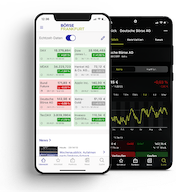"Low-volatility strategies: For a little less stock market drama"

Even though the stock markets achieved positive returns in the first seven months of the year, the ups and downs are likely to have stressed many investors. Low-volatility strategies can be helpful in such market phases. Ali Masarwah, fund analyst and managing director of financial services provider envestor, explains what lies behind these ETFs and funds.
28 July 2025. FRANKFURT (envestor): First, let's define the so-called low volatility factor. It brings together stocks whose prices have fluctuated less than the overall market in the past. That sounds trivial, and in a way it is: assets that fluctuate less tend to lose less, and therefore do not need to rise excessively to offset losses. Low-volatility strategies are considered a stable anchor, especially in times of crisis, and have helped to limit losses.
In the 1970s, economists such as Fischer Black questioned the capital asset pricing model (CAPM) that was prevalent at the time. They found that stocks with less volatility (lower beta) often yield even higher returns than riskier stocks. This relativized the old stock market rule of “no risk, no reward”—sometimes the opposite is true: less risk, more fun with your portfolio.
Why does this strategy work?
Many investors are looking for quick profits and focus on highly volatile, “exciting” stocks – similar to playing the lottery. As a result, less volatile stocks are less in demand, often valued more cheaply, and ultimately underestimated by the market. On top of that, some investors (such as fund managers) are not allowed to deviate too much from their benchmark index. Other investors cannot or are not allowed to use leverage. They therefore buy riskier stocks on the assumption that these will compensate for the lack of leverage. Some financial experts have put forward the theory that the low-volatility advantage stems from the fact that such stocks, similar to value stocks, are often already cheap and profitable.
Let's now turn to performance – how have low-volatility stocks performed in recent years? Compared to their “parent indices” (e.g., MSCI World), low-volatility indices have shown a mixed picture over the past 20 years:
- In times of crisis (e.g., 2002 to 2003, 2007 to 2009, 2018), they often perform better, sometimes reducing volatility by 30 percent.
- During strong upturns, they usually lag behind—sometimes significantly, as in 2023.
In addition, sudden structural breaks can lead to unpleasant surprises: this was precisely the case during the coronavirus crash, when low-volatility funds and ETFs were overwhelmed by the rapid shift from crash to recovery—and supposedly stable utilities and consumer stocks also fell victim to the so-called “quant winter.”
To measure performance, investors should use volatility, maximum loss, and risk-adjusted return, for example with the Sharpe ratio. Over long periods of time, these values for low-volatility portfolios are generally significantly better than those for the overall market, even when markets are trending upward. Low volatility therefore brings more return per unit of risk.
In practice: Who benefits from low volatility?
Those who want to avoid losses but still want to remain invested will find low-volatility stocks an alternative to “exiting completely.” This is no trivial matter, as many investors tend to exit at the worst possible time when losses are high. The strategy is therefore not only suitable for conservative investors. For many investors, it is important to “stay in the game.” Those who opt for low volatility do not necessarily liquidate their stock portfolio at the worst possible time.
Pitfalls and timing errors
Many private investors do not understand the advantages (risk-adjusted key figures such as the Sharpe ratio) – for them, outperformance “through the back door” remains difficult to grasp. In addition, many investors try to buy and sell low-volatility funds and ETFs at the optimal time. However, market timing does not work here either, because performance often comes as a surprise: those who enter the market after a good “run” with low volatility sometimes risk significant underperformance, because these strategies typically lag behind during market recovery phases. Furthermore, low volatility does not protect against losses in severe crises, but only mitigates them. In 2022, for example, the MSCI World Minimum Volatility Index lost 13.5 percent, while the overall market lost 20 percent. So even with low volatility, it's important to stay on the ball in the long term. Less drama on the stock market usually means a little less excitement during upturns, but it reduces the headaches during downturns.
By Ali Masarwah, 28 July 2025, © envestor.de
About the Author
Ali Masarwah is a fund analyst and managing director of envestor.de, one of the few fund platforms that pays cashback on fund distribution fees. Masarwah has been analyzing markets, funds, and ETFs for over 20 years, most recently as an analyst at the research firm Morningstar. His expertise is also valued by numerous financial media outlets in German-speaking countries.
This article reflects the opinion of the author, not that of the editorial team at boerse-frankfurt.de. Its content is the sole responsibility of the author.

More articles from this columnist
| Time | Title |
|---|




